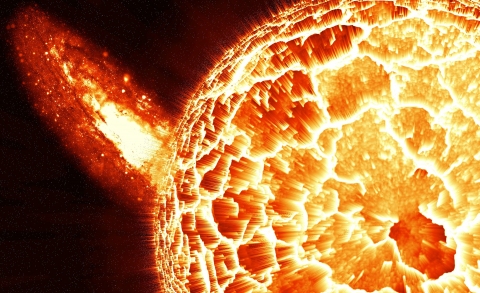
"Czerwona Księga" Autor: Carl Gustav Jung
Książkę tą prowadził od momentu rozejścia się jego drogi z Freudem - od 1914r. roku do 1930r. Zapisywał w niej i ilustrował wewnętrzne doświadczenia, wizje, myśli, które uznawał potem za “numinalny początek” z którego wywodziła się cała dalsza jego praca i odkrycia.
“Czerwona Księga”, albo jak ją nazywał Jung “Liber Novus”, zawiera obok treści zapisywanych w formie kaligraficznej, także szereg wizjonerskich obrazów.
Książka zamknięta była przez dziesięciolecia przed wzrokiem badaczy w sejfach banku w Zurichu, ale w końcu - dzięki zgodzie rodzinny Junga - ujrzała światło dzienne i stała się od razu bestsellerem, białym krukiem i oczkiem w głowie każdego jungisty.
Obok widzicie jej okładkę, a poniżej wybrany obraz stronę tej znamienitej księgi. Poniżej dołączamy także materiał filmowy na jej temat, fragment recenzji w języku angielskim, który ukazał się na łamach New York Times'a, opis książki ze strony 'Fundacji Filemon', nadzorującej publikację dzieł Junga, a także kilka ważnych linków dla tych z was, którzy są zainteresowani większą dawką informacji na ten temat.
Zapraszamy!
Redakcja
"During First World War Jung commenced an extended self-exploration that he called his “confrontation with the unconscious.” During this period, he developed his principal theories of the collective unconscious, the archetypes, psychological types and the process of individuation, and transformed psychotherapy from a practice concerned with the treatment of pathology into a means for reconnection with the soul and the recovery of meaning in life. At the heart of this endeavor was his legendary Red Book, a large, leather bound, illuminated volume that he created between 1914 and 1930, and which contained the nucleus of his later works. While Jung considered the Red Book, or Liber Novus (New Book) to be the central work in his oeuvre, it has remained unpublished till this day, and unavailable for study and unseen by the public at large. The work can be best described as a work of psychology in a literary and prophetic form. It is possibly the most influential unpublished work in the history of psychology. Its publication is a watershed that inaugurates a new era in the understanding of Jung’s life and work."
The years … when I pursued the inner images were the most important time of my life. Everything else is to be derived from this. It began at that time, and the later details hardly matter anymore. My entire life consisted in elaborating what had burst forth from the unconscious and flooded me like an enigmatic stream and threatened to break me. That was the stuff and material for more than only one life.
Everything later was merely the outer classification, the scientific elaboration, and the integration into life. But the numinous beginning, which contained everything, was then.”
— C. G. Jung
Fragment recenzji książki z NY Times'a:
"From 1914 until 1930, C. G. Jung recorded, revised, rewrote, recopied and painstakingly illustrated what he considered “the numinous beginning” from which all the rest of his work derived. “The Red Book,” or as Jung called it, “Liber Novus,” consisted of some 200 parchment pages of meticulous calligraphy and visionary paintings collected into a huge folio bound in red leather. While its content, either whole or in part, was made available to a handful of colleagues and patients, its publication was postponed until now, nearly 50 years after his death, because Jung feared the book’s potential impact on his reputation. After all, anyone who read it might conclude what Jung himself first suspected: that the great doctor had lost his mind. ..."
Całość na stronie NYT
WAŻNIEJSZE LINKI:


.jpg)

 (Opracowane na podstawie przedmowy Jerzego Prokopiuka do pracy: "Odpowiedzi Hiobowi" Carla Gustava Junga, Wyd. "Ethos", Warszawa 1995)
(Opracowane na podstawie przedmowy Jerzego Prokopiuka do pracy: "Odpowiedzi Hiobowi" Carla Gustava Junga, Wyd. "Ethos", Warszawa 1995)